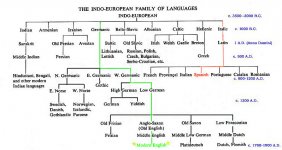noUseForAname
Regular Member
- Messages
- 240
- Reaction score
- 24
- Points
- 0
- Y-DNA haplogroup
- R1b-Z2705
Ye, ye, I was just trying to be precise. Phoenicia, Cyprus or Crete is my guess.
My problem with that theory is that for a mutation into E-V13 to happen in Balkans, there has to be a parent clade present (which is E-M78). If there was 100 males with E-M78 in Balkans, and one of them mutated into E-V13, then we'd have a starting ratio of 100:1 in favor of E-M78. Then why do we now have a totaly different ratio? There is 10x less E-M78 in Balkans, which means that E-V13 "prospered" thousand times better then E-M78. What could be explanation for that?
It's either that E-M78 colony on Balkans was extremely small, so that first E-V13 'mutant' could have disturbed the ratio at the very beginning of it's existence, or that E-V13 came into Balkans as an already formed subclade sometime later. This other hypothesis seems more probable for me.
You should ask Maciamo for this, although you are welcome to give personal opinions i would recommend to instead give scientific sources first before giving any opinions
Hopefully Maciamo would read this and will explain...so far this is what i have found and said from him regarding E-V13...to argue that E-V13 didn't came sometime later as you mention....
Originally Posted by Cobol19
I think E1b1b was probably hanging out in West Asia for a while until the movement happened to Europe, and among them there was likely J2 men as well.
Maciamo
That was what I thought before too. But that does not explain why E1b1b has a higher frequency than J2 in Western Iberia or the Southern Balkans. J2 is far more common than E1b1b in West Asia (ratio of almost 3:1). It also fails to explain why there is so little E-V13 in West Asia and the Levant. Furthermore, if Neolithic farmers and herders were only G2a, then how did E1b1b reach Iberia at all from the Middle East ?
Finally, the Dodecad admixture found a common Mediterranean element for South Europeans, North Africans and Middle Easterners alike. It is almost undeniable that this Mediterranean element comprises most or all E1b1b in Europe, and some E1b1b in North Africa (the E-M78, I would think). The best correlation is E-M78 + T + I (xI1/I2b). If European E1b1b came through Southwest Asia (Levant) and West Asia (Anatolia, Caucasus) and mixed with J2 or other haplogroups there before reaching Europe, we would expect much more West Asian and Southwest Asian admixture in Europeans. Instead, there is more Mediterranean admixture.


